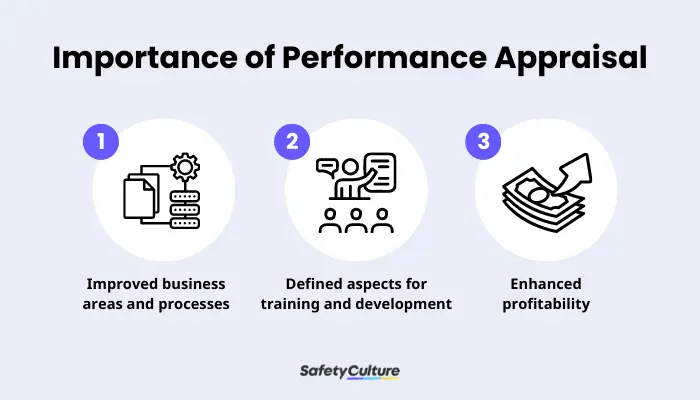What is a Performance Appraisal?
A performance appraisal is a periodic method of evaluating and documenting employees’ job performance in relation to the objectives and goals set for them within a specified time frame. Generally, it’s considered part of an organization’s overall performance management system, aimed at determining opportunities for improvement, reducing attrition rate, and boosting an organization’s culture and productivity.
Also referred to as employee evaluation, performance review, or employee appraisal, a performance appraisal is typically devised and conducted by the HR, supervisor, team leader, or team manager.
What is the Importance of Performance Appraisal?

Importance of Performance Appraisal
The importance of performance appraisal in an organization directly coincides with its advantages. Take a look at these factors and understand the benefits of performance appraisal.
Improved business areas and processes
Conducting performance appraisals lets you in on how an employee views the organization. During your one-on-one sessions and regular performance appraisals, part of the process is to ask for specific comments that the employee has regarding team dynamics, policies, and management. Then, leverage these findings and by turning them into actionable insights for your continuous improvement efforts like eliminating manual tasks with process automations.
Defined aspects for training and development
Ideally, performance appraisals must be a two-way street. Learning what employees need help with allows organizations to implement strategies for training workers more effectively. This is where people analytics become handy, as data and trends generated from such are key to identifying what kind of policies, initiatives, and systems are needed to be carried out. Hence, this benefits an employer’s resource allocation on training and focus on areas that are of utmost priority.
Enhanced profitability
Another notable importance of performance appraisal is that it ultimately puts emphasis on a business’s bottom line. Performance appraisals help employees and managers devise strategies to refocus their tasks, make them realize how their work makes a difference for the company, and align the company’s mission, vision, and values with their tasks and standard processes. This way, an “all hands on deck” approach can be achieved across the organization, allowing for maximum efficiency and streamlined processes toward profit-making operations.
What are Performance Appraisals Used For?
Commonly, organizations, team leaders, supervisors, and managers do performance appraisals to cover the following aspects:
- Setting goals
- Providing feedback
- Allowing employee self-development
- Allocating rewards and giving recognition
- Gathering information to make staffing and business decisions
- Motivating employees to improve productivity
- Developing training programs and development initiatives
Digitize the way you Work
Empower your team with SafetyCulture to perform checks, train staff, report issues, and automate tasks with our digital platform.
Get Started for FreeWhat are the Seven Elements of Performance Appraisal?
Every successful performance appraisal system has these 7 essential elements or components:
- Identified Goals and Objectives – These, along with a rating system and Key Performance Indicators (KPIs), are key to help in defining and achieving an employee’s Objective Key Results (OKRs) and enable the employee and the organization to measure performance effectively.
- Continuous Feedback – Detailed, consistent, and proactive feedback is crucial to employee growth. Hence, a performance appraisal process must ensure that ample feedback is given to employees for them to know their overall contribution and impact on the organization.
- Flexibility – In an effort to continuously improve an organization’s path to innovation and competitive advantage, a performance appraisal system must be flexible enough to be open to changes. One way to do this is by setting different Key Result Areas (KRAs) to fit each job description.
- Data-driven Insights – Apart from reducing attrition rate, people analytics also help an organization’s management pinpoint the overall relationship between an employee and a manager or team leader. This way, proactive decision-making can be achieved.
- Benefits and Rewards – A clear system for identifying the appropriate compensation, rewards, and recognition must be incorporated into employee engagement initiatives. This paves the way for increasing worker motivation, productivity, and a sense of belonging.
- Self-evaluation – This element of a successful performance appraisal enables employee accountability as they take charge of their own progress, monitor their performance, and challenge the rating or feedback given to them.
- Performance Improvement Plan (PIP) – Commonly given to employees who struggle meeting business objectives, PIPs are also key to identifying the next steps to help empower employees with the right tools and knowhow in order to improve their performance. This, along with the other elements, forms a proactive appraisal process.




